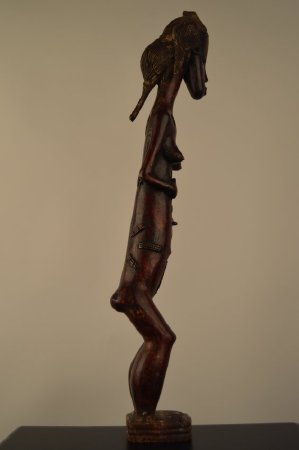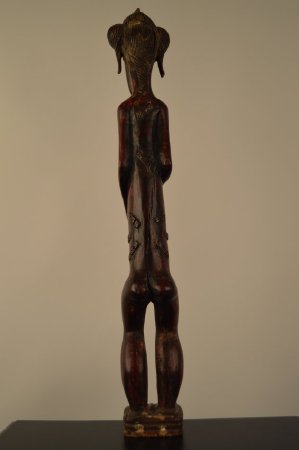Title:
Standing Female Figure
Object Name:
Figure, Standing, Female
Other Name:
Figure, Standing, Female
Place of Origin:
Baoule, Ivory Coast, Africa
Provenance:
Aboriginal Indigenous Art.
H = 24"
W = 4—1/2"
D = 5"
Baule art is sophisticated and stylistically diverse. Non—inherited, the sculptor’s profession is the result of a personal choice. The Baule have types of sculpture that none of the other Akan peoples possess. Wooden sculptures and masks allow a closer contact with the supernatural world. Baule statues are usually standing on a base with legs slightly bent, with their hands resting on their abdomen in a gesture of peace, and their elongated necks supporting a face with typically raised scarification and bulging eyes. The coiffure is always very detailed and is usually divided into plaits. Baule figures answer to two types of devotion: one depicts the “spiritual” spouse who, in order to be appeased, requires the creation of a shrine in the personal hut of the individual. A man will own his spouse, the blolo bian, and a woman her spouse, the blolo bla. The Baule believe that before they were born into the world they existed in a spirit world, where each one had a mate. Sometimes that spirit mate becomes jealous of their earthly mate and causes marital discord. When this happens, a figure depicting the other world spouse is carved and placated with earthly signs of attention.
H = 24"
W = 4—1/2"
D = 5"
Baule art is sophisticated and stylistically diverse. Non—inherited, the sculptor’s profession is the result of a personal choice. The Baule have types of sculpture that none of the other Akan peoples possess. Wooden sculptures and masks allow a closer contact with the supernatural world. Baule statues are usually standing on a base with legs slightly bent, with their hands resting on their abdomen in a gesture of peace, and their elongated necks supporting a face with typically raised scarification and bulging eyes. The coiffure is always very detailed and is usually divided into plaits. Baule figures answer to two types of devotion: one depicts the “spiritual” spouse who, in order to be appeased, requires the creation of a shrine in the personal hut of the individual. A man will own his spouse, the blolo bian, and a woman her spouse, the blolo bla. The Baule believe that before they were born into the world they existed in a spirit world, where each one had a mate. Sometimes that spirit mate becomes jealous of their earthly mate and causes marital discord. When this happens, a figure depicting the other world spouse is carved and placated with earthly signs of attention.
Description:
Standing female figure with elongated head, extended face, pointed chin, protruding mouth, small upturned nose. Almond—shaped slit eyes, large forehead, cloth covered hat with long hair in tail extending down back. Long neck, small shoulders, boneless bent arms carved close to body. Small protruding breasts, long rectangular body, scarification on stomach, sides and back. Boneless bent legs with large calves, flat feet on square wooden base. Scarification on shoulders, dark brown patina with black face and black under breasts.
Collection:
Finley Collection
Material:
Wood W/Patina
Used:
Ritually Used
Technique:
Carving / Painting
Owned:
Art Department, Missouri Southern State University
Accession#:
2014.1.42



